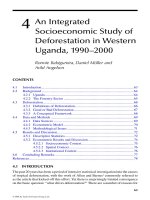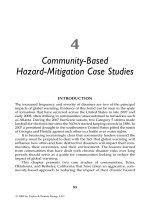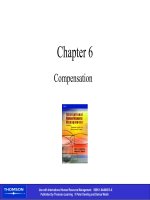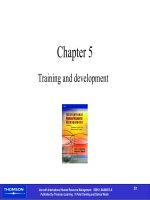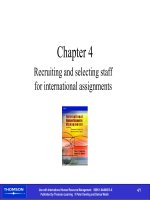International human resource management - Chapter 4 pot
Bạn đang xem bản rút gọn của tài liệu. Xem và tải ngay bản đầy đủ của tài liệu tại đây (920.53 KB, 30 trang )
1
Use with International Human Resource Management ISBN 1-84480013-X
Published by Thomson Learning © Peter Dowling and Denice Welch
4/1
Chapter 4
Recruiting and selecting staff
for international assignments
2
Use with International Human Resource Management ISBN 1-84480013-X
Published by Thomson Learning © Peter Dowling and Denice Welch
4/2
Chapter objectives
•
the myth of the global manager
•
the debate surrounding expatriate failure
(cont.)
In Part I, we demonstrated how people play a central role in
sustaining international operations. As international
assignments are an important vehicle for staffing, it is critical
that they are managed effectively, and the expatriates are
supported so that performance outcomes are achieved. The
focus of this chapter, then, is on recruitment and selection
activities in an international context. We will address the
following issues:
3
Use with International Human Resource Management ISBN 1-84480013-X
Published by Thomson Learning © Peter Dowling and Denice Welch
4/3
Chapter objectives (cont.)
•
factors moderating intent to stay or leave the international
assignment
•
selection criteria for international assignments
•
dual-career couples
•
are female expatriates different?
4
Use with International Human Resource Management ISBN 1-84480013-X
Published by Thomson Learning © Peter Dowling and Denice Welch
4/4
The global manager
•
Myth 1: there is a universal approach to
management
•
Myth 2: People can acquire multicultural
adaptability and behaviours
•
Myth 3: There are common characteristics
shared by successful international managers
•
Myth 4: There are no impediments to
mobility
5
Use with International Human Resource Management ISBN 1-84480013-X
Published by Thomson Learning © Peter Dowling and Denice Welch
4/5
Table 4-1: Current expatriate profile
6
Use with International Human Resource Management ISBN 1-84480013-X
Published by Thomson Learning © Peter Dowling and Denice Welch
4/6
Expatriate failure
•
Definition: Premature return of an
expatriate
•
Now recognized that under-performance
during an international assignment, and
retention upon completion, should be
included
7
Use with International Human Resource Management ISBN 1-84480013-X
Published by Thomson Learning © Peter Dowling and Denice Welch
4/7
Expatriate failure
•
What is the magnitude of the phenomenon?
–
Suggestion of a falling rate compared with
early (1980s) studies
–
Evidence is somewhat inconclusive
–
Discussion about its magnitude has drawn
attention to expatriate failure and prompted
considerable research into its causes
8
Use with International Human Resource Management ISBN 1-84480013-X
Published by Thomson Learning © Peter Dowling and Denice Welch
4/8
Expatriate failure
•
Direct costs of failure: airfares, associated
relocation expenses, and salary and training
–
Varies according to level of position concerned
–
Country of destination
–
Exchange rates
–
Whether ‘failed’ manager is replaced by
another expatriate
9
Use with International Human Resource Management ISBN 1-84480013-X
Published by Thomson Learning © Peter Dowling and Denice Welch
4/9
Expatriate failure
•
Indirect costs (invisible)
–
Damaged relationships with key stakeholders in
the foreign location
–
Negative effects on local staff
–
Negative effects on expatriate concerned
–
Family relationships may be affected
10
Use with International Human Resource Management ISBN 1-84480013-X
Published by Thomson Learning © Peter Dowling and Denice Welch
4/10
Factors moderating expatriate
performance
•
Inability to adjust to the foreign culture
•
Length of assignment
•
Willingness to move
•
Work-related factors
•
Psychological contract
11
Use with International Human Resource Management ISBN 1-84480013-X
Published by Thomson Learning © Peter Dowling and Denice Welch
4/11
Figure 4-1: International assignments: factors
moderating performance
12
Use with International Human Resource Management ISBN 1-84480013-X
Published by Thomson Learning © Peter Dowling and Denice Welch
4/12
Figure 4-2: The phases of cultural adjustment
13
Use with International Human Resource Management ISBN 1-84480013-X
Published by Thomson Learning © Peter Dowling and Denice Welch
4/13
The phases of adjustment
•
The U-Curve is not normative
•
The time period involved varies between
individuals
•
The U-Curve does not explain how and why
people move through the various phases
•
It may be more cyclical than a U-Curve
•
Needs to consider repatriation
14
Use with International Human Resource Management ISBN 1-84480013-X
Published by Thomson Learning © Peter Dowling and Denice Welch
4/14
Figure 4-3: The dynamics of the employment relationship
15
Use with International Human Resource Management ISBN 1-84480013-X
Published by Thomson Learning © Peter Dowling and Denice Welch
4/15
The employment relationship
•
The nature of the employment relationship
–
Relational: broad, open-ended and long-term
obligations
–
Transactional: specific short-term monetized
obligations
•
The condition of the relationship
–
Intact: when employee considers there has been fair
treatment, reciprocal trust
–
Violated: provoked by belief organization has not
fulfilled its obligations
16
Use with International Human Resource Management ISBN 1-84480013-X
Published by Thomson Learning © Peter Dowling and Denice Welch
4/16
Figure 4-4: Likelihood of exit
17
Use with International Human Resource Management ISBN 1-84480013-X
Published by Thomson Learning © Peter Dowling and Denice Welch
4/17
Organizational commitment
•
Affective component: employee’s
attachment to, identification with and
involvement in, the organization
•
Continuance component: based on
assessed costs associated with exiting the
organization
•
Normative component: refers to
employee’s feelings of obligation to remain
18
Use with International Human Resource Management ISBN 1-84480013-X
Published by Thomson Learning © Peter Dowling and Denice Welch
4/18
Why consider the psychological
contract?
•
Nature, location and duration of an international
assignment may provoke intense, individual
reactions to perceived violations
•
Expatriates tend to have broad, elaborate,
employment relationships with greater emphasis
on relational nature
•
Expectations and promises underpin this
relationship
19
Use with International Human Resource Management ISBN 1-84480013-X
Published by Thomson Learning © Peter Dowling and Denice Welch
4/19
Selection criteria
•
Technical ability
•
Cross-cultural suitability
•
Family requirements
•
Country-cultural requirements
•
MNE requirements
•
Language
20
Use with International Human Resource Management ISBN 1-84480013-X
Published by Thomson Learning © Peter Dowling and Denice Welch
4/20
Figure 4-5: Factors in expatriate selection
21
Use with International Human Resource Management ISBN 1-84480013-X
Published by Thomson Learning © Peter Dowling and Denice Welch
4/21
Mendenhall and Oddou Model
•
Self-oriented dimension
•
Perceptual dimension
•
Others-oriented dimension
•
Cultural-toughness dimension
22
Use with International Human Resource Management ISBN 1-84480013-X
Published by Thomson Learning © Peter Dowling and Denice Welch
4/22
Table 4-2: Harris and Brewster’s selection typology
23
Use with International Human Resource Management ISBN 1-84480013-X
Published by Thomson Learning © Peter Dowling and Denice Welch
4/23
Solutions to the dual-career
challenge
•
Alternative assignment arrangements
–
Short-term
–
Commuter
–
Other (eg. unaccompanied, virtual)
•
Family-friendly policies
–
Inter-company networking
–
Job-hunting assistance
–
Intra-company employment
–
On-assignment career support
24
Use with International Human Resource Management ISBN 1-84480013-X
Published by Thomson Learning © Peter Dowling and Denice Welch
4/24
Table 4-3: Barriers to females taking international assignments
25
Use with International Human Resource Management ISBN 1-84480013-X
Published by Thomson Learning © Peter Dowling and Denice Welch
4/25
Chapter summary
•
Four myths related to the concept of a global manager – that there is a
universal approach to management; that people can acquire multicultural
adaptability and behaviors; that there are common characteristics
successful international managers share; and that there are no
impediments to mobility.
•
The debate surrounding the definition and magnitude of expatriate
failure.
(cont.)
This chapter has addressed key issues affecting recruitment and
selection for international assignments. We have covered:
